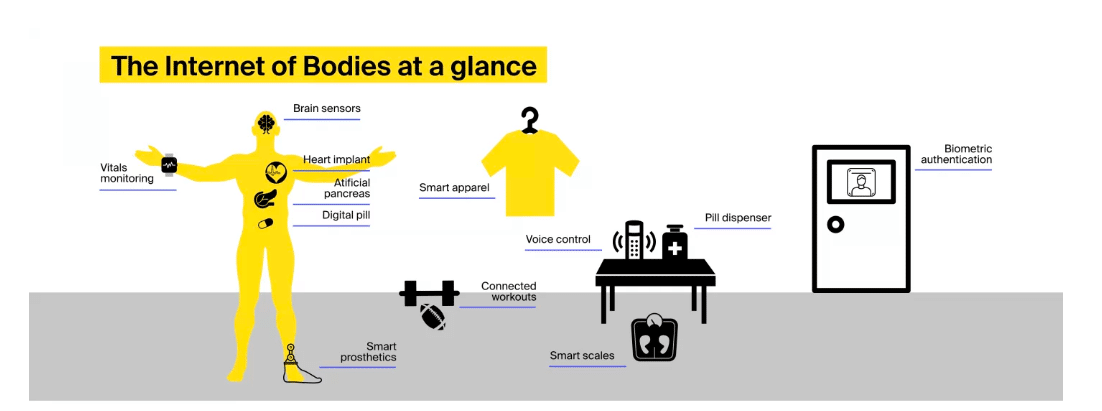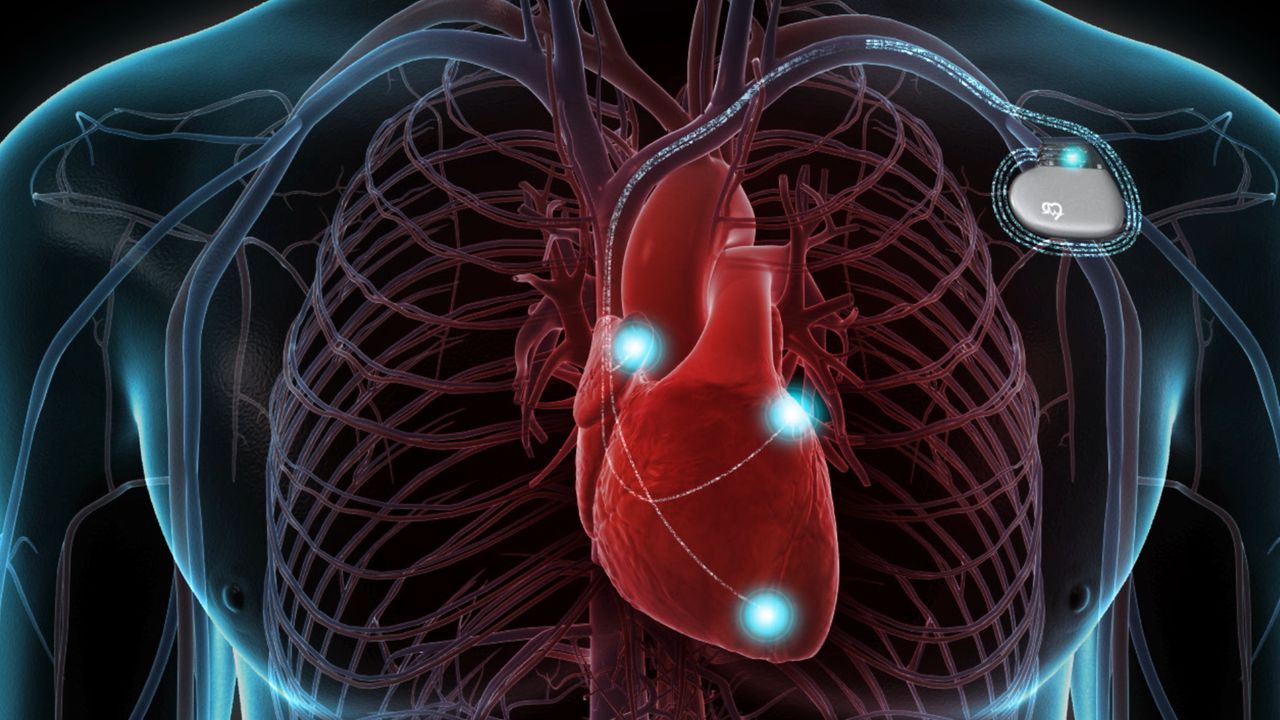
The Internet of Bodies (IoB) term was coined in 2016. It describes connected devices that monitor the human body, collects physiological, biometric, or behavioral data, and exchange information over a wireless or hybrid network. The Internet of Bodies and the Internet of Things falls under the broader IoT solutions umbrella.
There are some benefits of implementing IoB solutions at scale, including better diagnosis and treatment of health conditions, personalized insurance plans, increased productivity, and improved public safety, to name a few. But the growing Internet of Bodies adoption could also result in unauthorized access to sensitive information by third parties, income-based health disparities, and the installment of a global surveillance state. This is why the digitization of the human body raises substantial concerns.
Optimists, in general, believe that IoB brain implants could, for example, allow disabled people to control their prosthetic limbs, innovative stents can monitor blood clots, and artificial pancreases can manage blood-sugar levels in diabetic patients. Aldo deaf people can hear the sound, and blind people can see with the implementation of smart devices in the body.
Pessimists and skeptics believe that IoB devices and processes can invade our privacy, create significant risks for the integrity of our bodies, and cause loss of control over our bodies in cyberspace.
Both optimists and pessimists have valuable points. While the concept of IoB brings many health and well-being benefits to society, it also creates serious safety, security, privacy, and personal autonomy risks.
Just like other members of the Internet of Things family, IoB devices operate on four levels:
Hardware with limited or advanced computing capabilities. IoB devices are enhanced with embedded software and sensors measuring human-generated data. Depending on a gadget’s processing power, sensor data can be stored on the device or cloud. Combining invasive and wearable IoB devices into a wireless body area network (WBAN) is possible.
Networks, which can be wireless or hybrid. Connectivity technologies allow IoB systems to securely exchange data with each other and a central hub at preset intervals or in real-time.
Back-end infrastructure, which encompasses data storage, analytics, and visualization solutions. When it comes to IoB, the “infrastructure” team can also refer to a support system ensuring a gadget’s uninterrupted operation, such as a team of healthcare specialists ready to intervene should a personal help button be pressed.
End-user applications that allow individuals to configure IoB devices connect them to other hardware and apps and view sensor data over a given period. Although voice interfaces are also getting traction in the Internet of Things domain, these apps often run on mobile devices.
At this stage, the collection of IoB data is mainly from external parts of our bodies through a smartwatch or fitness devices analyzed in a central location by proprietary software of private companies. However, the long-term use alludes to disseminating information from internal organs, including the brain, making information available via an ecosystem supported by Internet communication protocols.
Some Applications of Internet of Bodies products
Consumer Internet of bodies devices
Connected home solutions
- Security cameras and door locks with face recognition capabilities
- Voice-controlled smart home devices
- Automatic pill dispensers
- Hearing aids
- In-home remote monitoring systems for the elderly and patients with chronic conditions
Fitness devices
- Wearable physical activity trackers, including innovative accessories
- Fitness mirrors with computer vision functionality
- Connected fabrics and apparel
- Training and weight measuring equipment enhanced with sensors
Medical Internet of bodies devices
Smart hospital solutions
- Connected hospital beds with vitals monitoring functionality
- Point-of-care testing equipment
- Stationary medication dispensers
- Integrated IoT systems for inpatient, outpatient, and remote patient care
Credit picture:https://www.wkhs.com/
Implantable and ingestible devices
- Organ systems: heart implants, artificial pancreas systems, innovative stents, cochlear implants for individuals with hearing loss, artificial retina implants
- IoT-based prosthetic limb systems
- Neurological IoB solutions: brain-computer interfaces (BCI) with implantable sensors, deep brain stimulation solutions, seizure monitors
- Digital pills for non-invasive diagnostic procedures and medication intake monitoring
The Risks of Internet of Bodies
-
Security Risks
IoB devices can be prone to the same security flaws as IoT devices or any other technology that stores information in the cloud. Vulnerabilities could allow unauthorized parties to leak private data, tamper with data, or lock users out of their accounts. But, given the nature of IoB devices and their data, the stakes are exceptionally high.
Moreover, it is not only a risk at an individual and national level. In the case of some implanted medical devices, hackers could potentially manipulate the apparatus to cause physical injury or even death. National security is also a concern because any IoB-collected data have the potential to reveal sensitive information, such as the location of U.S. service members. For example, in 2018, we read that the US soldiers re-revealed sensitive and dangerous information by jogging.
-
Ethical Concerns
Privacy and security risks are inherently ethical issues for the individuals whose data are compromised. But the IoB raises further ethical concerns, including inequity and threats to personal autonomy.
Without insurance coverage, internet access, or a certain level of tech-savviness, some groups could miss out on the IoB’s immediate benefits and its influence on public health initiatives in the long run. And because the IoB is in its infancy, there are still fundamental questions about whether individuals have ownership over their data or have the right to opt-out of data collection. At this regard, are we so sure that the body not only sends information but also receives information back too? This something obviously could risk plunging us into a dystopian future. Future in which it will no longer be the man to controls technology but the technology to controls man.
Conclusions
The serious question is whether we are ready to use IoB. We are not even close to being prepared. Considering the uncertainty and scary growth of the Internet, sharing information about our bodies can be stupid.
It will be significant that digital pills will tell doctors when we have taken our medicine, and digital diapers alert parents when their babies need to be changed in a safer ecosystem. But the Internet is not ready for this kind of sensitive information. Until double-blind clinical studies in real-life and integrated environments are conducted, clear definitions from standards institutes are provided, and ethical clearance and tight regulations are maintained, you will stay an exciting idea.
With these fundamental measures, we might still not eliminate all risks with these basic measures, but at least we can keep them under control and mitigate them as we learn more. However, without these fundamentals, considering IoB in real-life resembles jumping into a vast ocean without knowing how to swim.
Biotechnology has made significant improvements in healthcare and genetics areas. Some health care devices are safely used by medical professionals using secure channels. However, using these devices on the Internet is not as easy. All technology devices, including artificial intelligence, are prone to human errors.





Leave a Reply